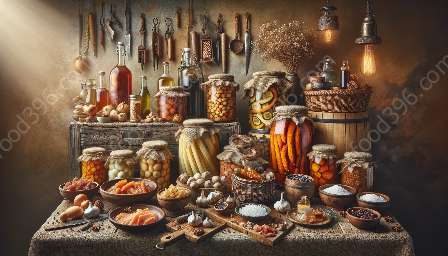Food preservation has been a vital aspect of human civilization for centuries. Throughout history, people have utilized various methods to ensure the availability of food during times of scarcity. In this article, we will delve into the historical background of food preservation techniques, the influence of culture and history, and the evolution of freezing and refrigeration as modern preservation methods.
Historical Food Preservation Techniques
Historically, food preservation was a critical means of survival, enabling societies to store and consume food beyond its natural spoilage period. The primary methods utilized for preserving food before the advent of modern technology included drying, smoking, salting, fermenting, and pickling.
Drying: Drying, which involves removing the moisture from food products, was one of the earliest methods of preservation. This technique was commonly used for fruits, vegetables, and meats, and it is still practiced in many cultures today.
Smoking: Smoking was a popular method for preserving meat and fish. The process involved exposing the food to the smoke generated by burning wood or other combustible materials, which imparted flavor and helped in preserving the food.
Salting: Salting, or the use of salt as a preservative, was widely employed to extend the shelf life of meat, fish, and vegetables. Salt inhibits the growth of spoilage-causing microorganisms, making it an effective preservation method.
Fermenting: Fermentation is a natural process that transforms food through the action of microorganisms. The preservation of foods such as cabbage (for sauerkraut) and milk (for yogurt and cheese) through fermentation was common in many ancient cultures.
Pickling: Pickling involved submerging food items in a solution of vinegar, brine, or other acidic liquids. This process not only preserved the food but also imparted a unique flavor profile.
Impact of Culture and History on Food Preservation
Culture and history played a crucial role in shaping food preservation methods. The techniques employed by different cultures were often influenced by factors such as climate, available resources, and culinary traditions. For example, in colder regions, freezing and ice-box storage was a natural and accessible method of food preservation. In warmer climates, sun-drying and fermentation were more prevalent.
Furthermore, the historical significance of certain preserved foods has contributed to cultural identity and culinary traditions. For instance, preserved fish and meats have been staple components of many regional cuisines, reflecting the historical necessity of preserving protein-rich foods.
Evolution of Freezing and Refrigeration
The development of freezing and refrigeration marked a significant turning point in the history of food preservation. Prior to the invention of mechanical refrigeration, natural ice was harvested and stored in icehouses for later use. The availability of ice facilitated the preservation of perishable foods and enabled the creation of ice cream and other frozen treats.
In the 19th century, the invention of the mechanical refrigerator transformed the storage and preservation of food. This innovation allowed for precise temperature control and significantly extended the shelf life of perishable items. The widespread adoption of refrigeration in households and commercial sectors revolutionized the food industry and contributed to the globalization of food distribution.
Today, freezing and refrigeration are fundamental methods of food preservation, offering unmatched convenience and reliability. From frozen fruits and vegetables to refrigerated dairy products and meats, modern consumers have access to an extensive array of preserved foods, thanks to these technologies.
Traditional Methods in Contemporary Food Preservation
While freezing and refrigeration have become dominant forms of food preservation in modern times, traditional methods continue to hold relevance in many culinary traditions. The art of pickling and fermenting has experienced a revival, with more individuals and restaurants exploring the unique flavors and health benefits associated with these preservation techniques.
Moreover, the slow food movement and the resurgence of interest in heirloom and heritage foods have propelled traditional preservation methods into the spotlight. Consumers are increasingly seeking out artisanal products that employ age-old preservation techniques, recognizing their cultural significance and distinctiveness.
Conclusion
Understanding the historical context of food preservation techniques provides valuable insights into the impact of culture and history on the development of freezing and refrigeration. While modern technologies have revolutionized the way we preserve food, traditional methods continue to enrich our culinary landscape and contribute to the preservation of cultural heritage.

